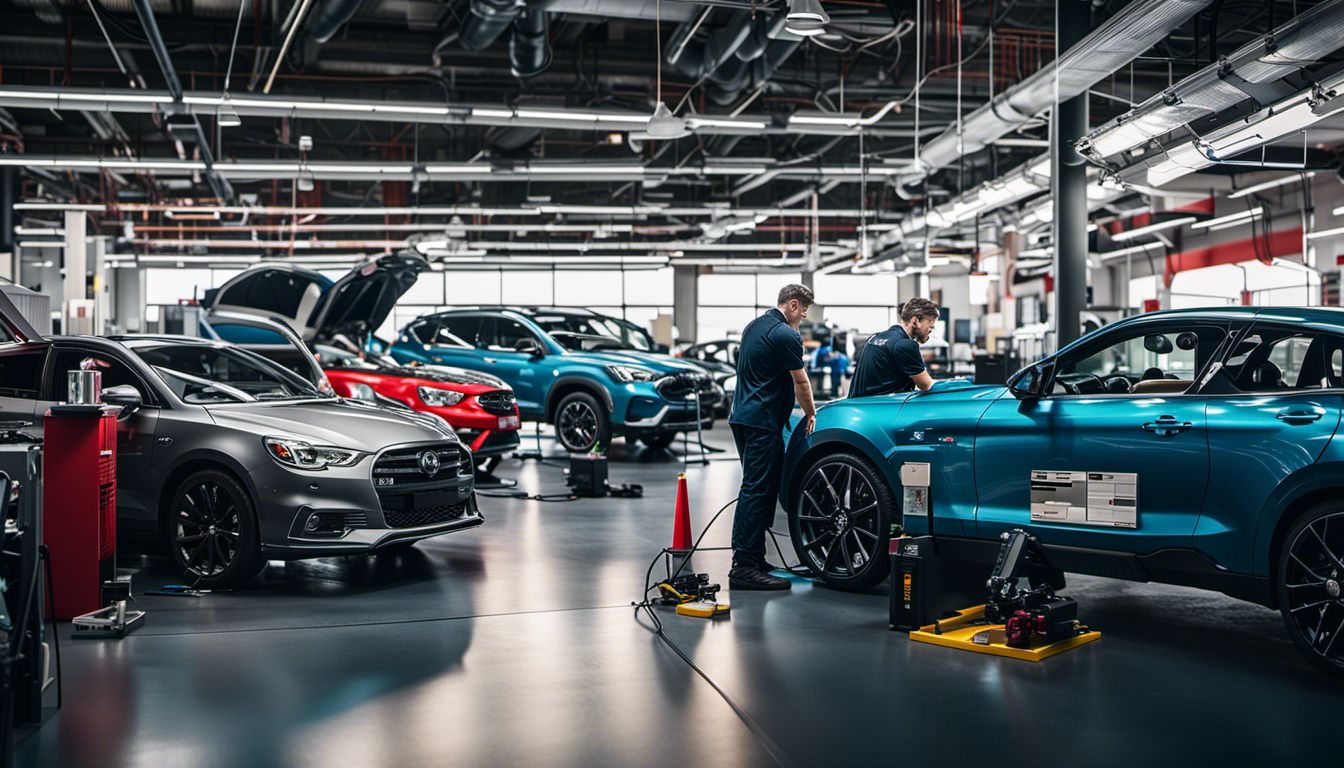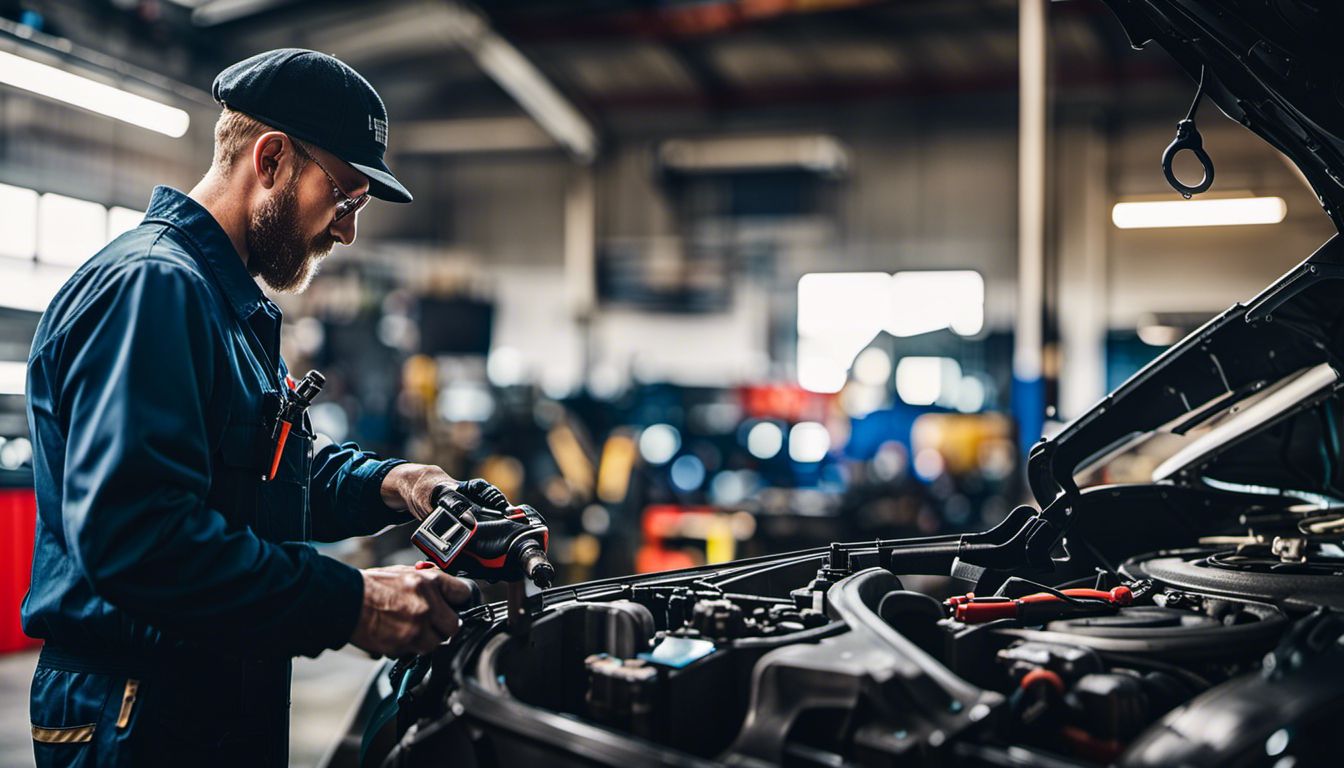Are you looking to boost your dealership’s success and profitability through effective fixed operations? With nearly half of the total gross profits coming from Fixed Ops Revenue, as reported by NADA, this department is essential for your business growth.
This enlightening article will provide valuable insights into the crucial role of fixed ops in boosting dealership earnings and ways to leverage it effectively. Don’t miss out: read on for strategies that could transform your bottom line!
Key Takeaways
- Fixed Ops revenue makes up nearly half of a dealership’s total gross profits, exceeding new-vehicle and used-car sales.
- Training in fixed operations improves customer satisfaction and increases profits for dealerships.
- Consistent processes, effective management of customer traffic, employee education, and strong leadership are essential elements for a profitable fixed ops strategy.
Understanding the Role of Fixed Ops in Dealership Success

The success of a dealership hinges significantly on the indispensable role played by Fixed Ops, where service and parts emerge as pivotal components crucial to the overall operational triumph.
These parts and services keep the car place running smoothly and ensure a solid, lasting experience for customers.
In the intricate web of dealership operations, the Fixed Ops department stands as the linchpin, orchestrating a harmonious symphony of services and parts that not only meet but exceed the expectations of customers, ensuring a lasting and positive imprint in the competitive automotive landscape.
The Importance of Service and Parts
Service and parts play a pivotal role in the financial success of a dealership. With fixed ops revenue making up nearly half of a dealership’s total gross profits, it surpasses both new-vehicle and used-car sales.
This segment of operations has seen an approximate 5% increase in total gross profits within one year, while earnings from new car sales have declined by an equal percentage. As more people hold onto their vehicles for longer periods, fewer late-model cars need warranty work.
This shift heightens the importance of service and parts profits for overall dealership profitability. In order to achieve a 100% absorption rate or cover overhead costs with gross profits, dealerships must focus on boosting customer pay parts and labor gross profit through increased profit margins, greater sales per repair order, and attracting more customers.
The Impact of New Car Sales Fluctuations

New car sales, an influential factor in the automotive industry, often experience fluctuations due to a myriad of external influences. One such influence is consumer preference, which has been shifting towards late-model vehicles.
This shift, coupled with pandemic-related disruptions, has resulted in a dip in new vehicle sales fluctuation. The gross earnings from these sales dropped approximately 5% within a twelve-month span, directly affecting dealership earnings and overall profitability.
Dealership operating costs remain constant or might even rise amidst these changes; hence, sustained dips in new car sales elevate financial pressure on dealerships. An interesting side effect of decreased new car sales is vehicle owners keeping their cars longer than before, which can lead to increased service and parts profits as older vehicles require more upkeep.
The Necessity of Fixed Ops Training for Profitability

Investing in comprehensive training for fixed operations proves to be indispensable for enhancing dealership profitability.
Honing the skills and expertise within this crucial department not only contributes to heightened customer satisfaction but also serves as a catalyst for the overall augmentation of profits.
The symbiotic relationship between adept training in fixed operations and the subsequent elevation in customer contentment establishes a solid foundation for sustained financial gains, positioning the dealership for long-term success in the competitive automotive landscape.
How Training Improves Customer Satisfaction

Training programs can significantly enhance the aptitude and skills of dealership staff. Equipped with proper knowledge, employees become more adept at managing customers’ needs and resolving their issues promptly.
This goes a long way in boosting customer satisfaction rates.
A well-trained team is capable of providing quick, accurate, and personalized services to customers. Their proficiency leads to swift service delivery, which reduces the waiting time for customers.
Also, when employees understand vehicles better due to their training, they can explain issues or repairs more effectively to clients. All these factors culminate in a positive experience for consumers, leading to greater customer loyalty.
The Connection Between Training and Increased Profits

Fixed ops training plays a crucial role in driving increased profits for dealerships. By investing in employee education and development, dealerships can improve customer satisfaction levels, leading to higher sales and revenue.
Studies have shown that fixed ops revenue accounted for nearly half of total gross profits for dealerships. With proper training, employees are better equipped to provide exceptional service, upsell maintenance and repair work, and effectively communicate with customers.
This results in improved customer loyalty and retention, ultimately driving profitability higher. Moreover, trained employees also tend to be more efficient in their work, reducing the potential for errors or delays that could impact overall dealership performance.
Exploring the Key Elements of a Profitable Fixed Ops Strategy

I’ll focus on how consistent processes, managing customer flow, and improving employee education are crucial.
By breaking down the details of these elements, we aim to help you understand how combining them smoothly can strengthen how things run.
This doesn’t just boost efficiency but also sets the stage for creating a profitable fixed ops strategy that fits with the big goals of the company.
Consistent Processes that Lead to Profit

Consistent processes are essential for driving profitability in fixed ops departments. They help streamline operations and ensure that every step is carried out efficiently.
Here are some key elements that contribute to consistent and profitable processes:
Standardized workflows and procedures: Implementing standardized workflows ensures that tasks are completed consistently and efficiently, reducing errors and delays.
Effective communication channels: Establishing clear communication channels between service advisors, technicians, and parts personnel helps minimize miscommunication and delays in service delivery.
Efficient inventory management: Maintaining an accurate inventory system ensures that the right parts are available when needed, reducing downtime for customers.
Streamlined scheduling and appointment systems: Implementing efficient scheduling systems helps manage customer traffic effectively, minimizing wait times and maximizing productivity.
Emphasis on quality control: Incorporating regular quality control checks throughout the service process helps identify issues early on and ensures that repairs are done correctly the first time.
Robust training programs: Providing ongoing training for staff members ensures they stay up-to-date with the latest industry standards and best practices, improving overall performance and customer satisfaction.
Managing Customer Traffic and Providing Support

Dealerships face the challenge of managing customer traffic effectively and providing exceptional support to ensure customer satisfaction. By implementing efficient processes and utilizing digital tools, dealerships can improve service throughput and reduce wait times for customers.
This includes adopting transparent policies, implementing online appointment scheduling systems, and utilizing automatic dispatch programs to streamline the service process.
By prioritizing timely communication, dealership personnel can keep customers informed about their vehicles’ progress and any recommended repairs or maintenance needed.
Effective management of customer traffic not only enhances the overall customer experience but also increases profitability by maximizing service department efficiency.
Optimizing Employee Education with Hands-On Guidance

Dealerships can optimize employee education by providing hands-on guidance. This approach ensures that employees receive practical training and support, enabling them to acquire the necessary skills and knowledge to excel in their roles.
Through hands-on guidance, employees have the opportunity to apply what they learn in real-life scenarios, fostering a deeper understanding of dealership operations and customer service.
By investing in employee education with a focus on hands-on guidance, dealerships can enhance performance, increase customer satisfaction, and ultimately drive profitability.
The Role of Effective Leadership in Fixed Ops Success

The role of effective leadership in the success of fixed ops cannot be overstated.
This encompasses not only the development of managers and leaders within the service department but also the establishment of clear, well-defined goals and key performance indicators (KPIs).
A robust leadership approach is not just a supportive structure; it serves as the guiding force that propels the entire fixed ops framework toward sustained success.
By investing in the cultivation of managerial and leadership prowess while concurrently setting transparent benchmarks, the pathway to excellence in the service department becomes not just a goal but a tangible reality, fostering an environment primed for continual growth and accomplishment.
Developing Managers and Leaders in the Service Department

Developing managers and leaders in the service department is crucial for achieving success in fixed ops. It helps to improve overall performance, increase efficiency, and drive profitability. Here are some key strategies for developing managers and leaders in the service department:
- Provide comprehensive training programs: Offer training sessions and workshops that cover a wide range of topics, including customer service, sales techniques, problem-solving skills, and operational best practices. This will enhance their knowledge and expertise in managing the service department effectively.
- Encourage continuous learning: Encourage managers and leaders to pursue ongoing education and professional development opportunities. This can include attending industry conferences and workshops or enrolling in relevant courses or certifications. It will help them stay updated with the latest trends and technologies in the automotive industry.
- Foster a culture of mentorship: Pair experienced managers with new or aspiring leaders to provide guidance, support, and hands-on training. This mentorship program will allow them to learn from seasoned professionals, gain valuable insights, and develop their leadership skills.
- Set clear expectations and goals: Clearly define performance expectations and set measurable goals for managers and leaders. This will keep them focused on achieving specific targets related to customer satisfaction, employee retention, revenue growth, and overall profitability.
- Provide regular feedback: Regularly evaluate the performance of managers and leaders through performance reviews or one-on-one meetings. Offer constructive feedback to highlight areas of improvement while also acknowledging their successes. This feedback loop will motivate them to strive for excellence.
The Importance of Clear Goals and Key Performance Indicators (KPIs)
-37f84e0ad2-3731189828.jpg)
Clear goals and Key Performance Indicators (KPIs) play a pivotal role in the success of fixed ops. They not only provide a roadmap for the dealership’s service department but also help quantify performance.
| Importance | Details |
|---|---|
| Direction for the Team | Clear goals give a sense of direction to the fixed ops personnel, ensuring they understand what is expected from them and can focus on relevant tasks. |
| Performance Tracking | KPIs help in tracking the performance of the fixed ops, thereby enabling the dealership to understand where improvements are needed. A well-defined KPI, like the rise in gross profits by around 5% in twelve months, can be a solid benchmark. |
| Counter Rising Costs | With dealership operating costs increasing by an average of 6.5%, a strong focus on KPIs can help identify areas where efficiency can be increased to offset these rising costs. |
| Improve Customer Satisfaction | Goals and KPIs related to customer satisfaction can lead to enhanced service and parts departments. As well-trained fixed ops teams can reduce come-backs, thus increasing customer satisfaction. |
| Enhance Advisor Selling Skills | When units in service and warranty work are declining, having clear goals and KPIs can help in enhancing advisor selling skills, a crucial element for success in fixed ops. |
Conclusion- Fixed Ops Leaderboards

In order to achieve dealership success and profitability, fixed ops leaders must focus on key elements such as consistent processes, managing customer traffic, and optimizing employee education.
By developing effective leadership in the service department and setting clear goals with key performance indicators (KPIs), dealerships can increase their profits and drive customer satisfaction.
With the ever-changing automotive industry landscape, staying ahead of the curve with training and strategic initiatives will position dealerships for long-term success.
FAQs
1. What is a Fixed Ops Leaderboard?
A Fixed Ops Leaderboard is a tool or system used in the dealership industry to track and measure the success and profitability of various departments within a dealership’s fixed operations, such as service, parts, and collision repair.
2. How can a Fixed Ops Leaderboard help improve dealership success?
By providing real-time data and analysis on key performance indicators (KPIs), a Fixed Ops Leaderboard helps dealerships identify areas for improvement and make informed decisions to drive profitability. It allows managers to monitor departmental performance, set goals, motivate teams, and implement strategies that lead to greater success.
3. What KPIs are typically measured on a Fixed Ops Leaderboard?
Common KPIs tracked on a Fixed Ops Leaderboard include customer satisfaction scores, average repair order value, technician productivity rates, parts inventory turnover rate, labor efficiency ratio, percentage of repeat business, and vehicle turnaround time, among others. These metrics provide insights into operational efficiency and financial performance.
4. Can small dealerships benefit from implementing a Fixed Ops Leaderboard?
Absolutely! A Fixed Ops Leaderboard can be valuable for dealerships of all sizes. Small dealerships can benefit by gaining visibility into their operational performance at an individual employee level or department level. This enables them to identify opportunities for growth and ensure they are operating efficiently to maximize profits while delivering exceptional customer experiences.




